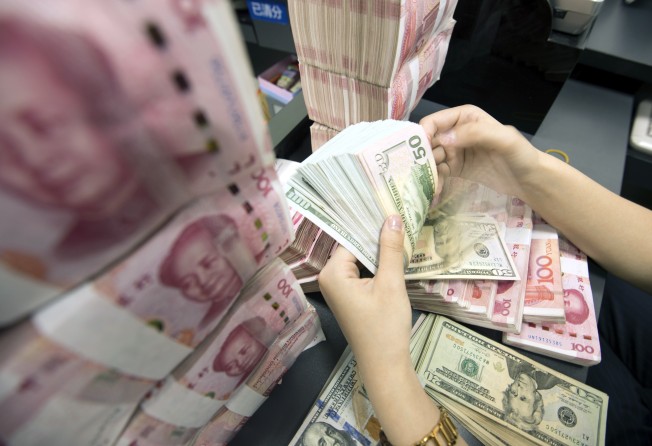China’s 2019 foreign direct investment grew most in two years, but outbound investment fell 6 per cent
- Foreign direct investment (FDI) in China in 2019 rose 5.8 per cent from a year earlier to 941.5 billion yuan (US$137 billion), the commerce ministry said on Tuesday
- China’s outbound direct investment (ODI) declined 6 per cent to 807.95 billion yuan (US$118 billion)

Foreign direct investment in China in 2019 grew the most in two years, though outbound investment declined amid continuing capital controls.
Foreign direct investment (FDI) was up 5.8 per cent year-on-year to 941.5 billion yuan (US$137 billion) last year, the commerce ministry said on Tuesday, the biggest rise since 2017, when it grew 7.9 per cent in yuan terms.
China remained the second largest recipient of FDI globally, said Chinese vice-commerce Minister Qian Keming on Tuesday in Beijing.
China’s outbound direct investment (ODI) declined 8.2 per cent to US$110.6 billion in 2019, said Qian.
The structure of ODI was more “balanced” with most flows to rental and commercial services, manufacturing, distribution and retail, Qian added.
China’s non-financial ODI rose just 0.3 per cent in 2018 having dropped sharply in 2017 as authorities kept a tight grip on outflows for what they termed “irrational” overseas projects.
Qian said US$15 billion of investment accounting for 13.6 per cent of the total flowed to countries as part of the Belt and Road Initiative, China’s ambitious plan to build a modern version of the Silk Road to link China with Asia, Europe and beyond through large-scale infrastructure projects.
Investment by Chinese firms was once a significant driver of global asset prices from property to mergers and acquisitions, but it has fallen sharply since Beijing tightened capital controls in 2016.
In yuan terms, China’s total ODI declined 6 per cent to 807.95 billion yuan (US$118 billion) in 2019.
According to the United Nations (UN), foreign direct investment (FDI) flows to developing economies remained stable at an estimated US$694 billion last year, led by China with a flat US$140 billion.
FDI dipped slightly around the world last year, hit by massive divestment in Hong Kong and a drop in flows into Britain due to Brexit uncertainty, the UN trade and development agency UNCTAD said in a report on Monday.
Hong Kong’s economy is a solid economy. Longer term-wise, it is attractive for international investment
FDI could rise marginally in 2020 on the back of modest growth as trade tensions between China and the United States ease, but geopolitical uncertainties and protectionist pressures are tempering expectations, it said.
In 2019, global FDI flows were estimated at US$1.39 trillion, down 1 per cent from a revised US$1.41 trillion in 2018.
FDI, which includes cross-border mergers and acquisitions, intra-company loans and investments, is a bellwether of globalisation and a potential sign of future growth of corporate supply chains.
Investment flowing into Hong Kong, the Asian financial hub that has been wracked by political unrest, nearly halved last year to US$55 billion, the report said.
Hong Kong’s economy is a solid economy. Longer term-wise, it is attractive for international investment
“In Hong Kong there was US$48 billion of divestment in terms of equity,” James Zhan, UNCTAD’s senior director of investment and enterprise, told Reuters. He noted that Hong Kong was also affected by China-US trade tensions.
Competition from Shanghai and Shenzhen in mainland China, as well as Singapore for high-end FDI, such as regional business hub functions and research and development activities of multinationals, also weighed on Hong Kong, he said.
“Hong Kong’s economy is a solid economy. Longer term-wise, it is attractive for international investment,” Zhan said.
Britain, beset by uncertainty last year over the outcome of Brexit but now on course to leave the European Union at the end of January, saw inward FDI flows shrink by 6 per cent to an estimated US$61 billion last year, according to the report.
FDI flows to developed economies fell by 6 per cent last year to an estimated US$643 billion, and remained at a historically low-level, at half of their peak in 2007, it said.
FDI to the European Union as a whole fell by 15 per cent to US$305 billion, as several countries experienced “strong volatility”, it said.
The European Union and some member states have tightened their FDI entry screening, particularly over “national security concerns”, Zhan said, and this could deter some FDI especially in technology.
Flows to the UUS, the largest FDI recipient worldwide, were stable at US$251 billion. The report said the impact of a 2017 US tax reform that reduced US outward FDI flows appears to have ebbed.